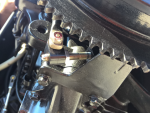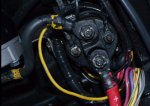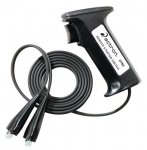Hello,
I recently purchased a bayliner capri 1700 ls with an 1995 Force 120 hp outboard motor. I know..some say "friends dont let friends buy bayliners.." Its my first boat ever and i didnt know much about outboard and marine engines. Im an engineer and somehow mechanically inclined..and i wished i did a bit more research before buying the boat but..long story short now im stuck with it and trying to make the best out of it.
The boat runs great, it reaches about 40 mph at 5500 rpm and the only real problem was the idle..i'm be able to start it only with the throttle pressed about half way (even when is warmed up , not sure if this is the norm or should start with just the shock- key pressed) and then even when it warms up it would die shortly after being in neutral, it idles around 600 rpms. I knew this is very low and the potential cause of the issue..so i took it to a friend that used to be a marine mechanic for a long time but never worked on a force engine. He cleaned the carbs, adjusted idle..speed, carburetor and with a water hose attached it would idle at 1200. Great! i left for vacation and brought the boat with me.. ..it started very easy first time ..but after a few minutes running, the idle fell to around 600 rpms and it would die in neutral - it would take me 3-4 attempts to get it in gear from neutral. Unfortunately, I dont have access to my mechanic friend again..and would like to try to fix it myself...he had advised me the timing and carburetors are all set and if the idle is not running as it should in the water, i should just try to adjust the timing rod (screw next to flywheel)..I did that and after a few turns (clockwise) i managed to have it running at around 1000 rpms. At this point it would start right away..no need to accelerate in neutral. I ran the boat and minutes later again, idle fell again to 600 rpms, and same story..it would not start without acceleration. I noticed the nut holding the screw it would move towards the center of the screw..so probably from the vibration the screw would not keep its position. I attached the picture..with the screw ..after the adjustment I would find the nut to where the green mark is. So my question is..should I tighten the nut with a wrench while keeping the screw in the same position? Am I missing a spring there that should keep the pressure on the screw and prevent the nut moving? is the nut in the right position ?
I havent done a compression test yet..mostly cause of the fear of very bad news (spent all my savings on this boat)..but i keep thinking if the boat reaches 40mph and works well most of the time, compression its not an issue.
(spent all my savings on this boat)..but i keep thinking if the boat reaches 40mph and works well most of the time, compression its not an issue.
Another question i have should i use Seafoam motor treatment? if yes, should i use this all the time or just one - two tanks of gas?
thank you all for reading and i appreciate any advise you guys can give me.
Eugene

I recently purchased a bayliner capri 1700 ls with an 1995 Force 120 hp outboard motor. I know..some say "friends dont let friends buy bayliners.." Its my first boat ever and i didnt know much about outboard and marine engines. Im an engineer and somehow mechanically inclined..and i wished i did a bit more research before buying the boat but..long story short now im stuck with it and trying to make the best out of it.
The boat runs great, it reaches about 40 mph at 5500 rpm and the only real problem was the idle..i'm be able to start it only with the throttle pressed about half way (even when is warmed up , not sure if this is the norm or should start with just the shock- key pressed) and then even when it warms up it would die shortly after being in neutral, it idles around 600 rpms. I knew this is very low and the potential cause of the issue..so i took it to a friend that used to be a marine mechanic for a long time but never worked on a force engine. He cleaned the carbs, adjusted idle..speed, carburetor and with a water hose attached it would idle at 1200. Great! i left for vacation and brought the boat with me.. ..it started very easy first time ..but after a few minutes running, the idle fell to around 600 rpms and it would die in neutral - it would take me 3-4 attempts to get it in gear from neutral. Unfortunately, I dont have access to my mechanic friend again..and would like to try to fix it myself...he had advised me the timing and carburetors are all set and if the idle is not running as it should in the water, i should just try to adjust the timing rod (screw next to flywheel)..I did that and after a few turns (clockwise) i managed to have it running at around 1000 rpms. At this point it would start right away..no need to accelerate in neutral. I ran the boat and minutes later again, idle fell again to 600 rpms, and same story..it would not start without acceleration. I noticed the nut holding the screw it would move towards the center of the screw..so probably from the vibration the screw would not keep its position. I attached the picture..with the screw ..after the adjustment I would find the nut to where the green mark is. So my question is..should I tighten the nut with a wrench while keeping the screw in the same position? Am I missing a spring there that should keep the pressure on the screw and prevent the nut moving? is the nut in the right position ?
I havent done a compression test yet..mostly cause of the fear of very bad news
Another question i have should i use Seafoam motor treatment? if yes, should i use this all the time or just one - two tanks of gas?
thank you all for reading and i appreciate any advise you guys can give me.
Eugene


Last edited:























